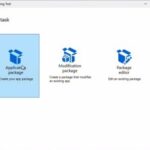ICYMI | Stand out in the marketplace with a Microsoft Copilot specialization
July 24, 2025
MSIX Packaging Tool: Convert EXE & MSI to MSIX
July 24, 2025We are proud to announce the general availability of Microsoft Connected Cache on July 23, 2025, to Enterprise and Education organizations. We thank partners and customers who have participated in the preview program for their valuable feedback, which has helped us refine Connected Cache into a production-ready solution. Connected Cache helps organizations realize significant bandwidth savings when performing Windows 11 upgrades, Microsoft Intune provisioning, Intune application installations, Windows Autopilot software updates, and other monthly update deployments.
As more organizations move to a cloud-native approach to device management, internet bandwidth consumption has become a major pain point. Without on-premises distribution points running Configuration Manager, customers have seen their network bandwidth consumption skyrocket as all their devices attempt to download updates directly from Windows Update over the internet.
Microsoft Connected Cache for Enterprise and Education is available to all organizations with Windows Enterprise (E3, E5, and F3) or Windows Education (A3 and A5) entitlements, or a more comprehensive Microsoft 365 subscription. Eligible organizations can deploy Connected Cache nodes directly to host machines running Windows Server, Windows Desktop, and Linux [Ubuntu and Red Hat Enterprise Linux (RHEL)].
One of the standout benefits of Microsoft Connected Cache is its remarkable flexibility—it can be deployed on almost any platform within your existing infrastructure, including Windows Server, Windows Desktop, and popular Linux distributions like Ubuntu and Red Hat Enterprise Linux. This versatility ensures that organizations of all sizes and architectures can take advantage of its features without the need for significant hardware changes or investments. Connected Cache works efficiently by caching only the content specifically requested by devices on your organization’s network, eliminating unnecessary storage use and reducing redundant downloads. As a result, bandwidth consumption is decreased, and users benefit from faster, more reliable access to updates and applications.
Connected Cache and Delivery Optimization work together to save you bandwidth
While Delivery Optimization is mostly known for being a peer-to-peer delivery solution, it is also the Windows downloader component that pulls Microsoft content from the cloud and provides enterprise and education users with tools to manage bandwidth traffic, throttling capabilities, and more.
Connected Cache complements Delivery Optimization peer-to-peer as a dedicated software caching solution that can be deployed within your network. Once deployed to a host machine within your network, the Connected Cache node will transparently and dynamically cache the Microsoft-published content that your organization’s Windows devices need.
Using this solution, content requests from Delivery Optimization can be served by the locally deployed Connected Cache node instead of a content delivery network. This results in fast, bandwidth-efficient delivery across connected devices on your network.
Connected Cache now uses a Windows installer for cache node deployment to Windows
To better streamline the installation and update process for Windows-hosted cache nodes, Connected Cache now leverages a Windows installer application for deployment to Windows host machines.
The Connected Cache installer is a command line application that offers easy deployment and updating of Windows-hosted cache nodes. It also lays the groundwork for future app capabilities such as new observability and troubleshooting tools.
Connected Cache can be configured to support Intune and Teams content requests via HTTPS
To meet evolving content delivery requirements from Microsoft content publishers, Connected Cache now supports both HTTP and HTTPS protocols. This enhancement ensures that Connected Cache can seamlessly cache and serve content regardless of the publisher’s delivery method. The added flexibility allows organizations to adapt to changing publisher requirements without compromising performance or efficiency. Notably, this update enables access to Teams content via Connected Cache for the first time—an important expansion of supported content types.
As Intune transitions to requiring HTTPS content delivery, this feature ensures continued compatibility and uninterrupted caching benefits. To enable HTTPS support, IT administrators must deploy a certificate to Connected Cache. Configuration guidance is available in the public documentation. This update reinforces Microsoft Connected Cache’s role as a secure, adaptable, and enterprise-ready caching solution aligned with modern content delivery standards.
Deploy Microsoft Connected Cache for Enterprise and Education
Microsoft Connected Cache is a flexible caching solution that saves bandwidth and speeds up access to updates and applications without major hardware changes, helping you keep your organization’s devices productive and secure. It is free to use for organizations with eligible Windows Enterprise and Education entitlements.
To get started, customers can use the Azure Marketplace to create “Microsoft Connected Cache for Enterprise and Education” Azure resources. Once the Connected Cache Azure resource has been created, organizations can create, configure, and deploy as many cache nodes as required to support their network topologies and content delivery needs. While access to Azure is required for usage and management, the Connected Cache Azure resource does not incur any Azure cost.
Please see the Microsoft Connected Cache for Enterprise and Education documentation overview page for more details. Full details on the GA release can be found in the Release Notes public documentation. Start using Connected Cache today!
Continue the conversation. Find best practices. Bookmark the Windows Tech Community, then follow us @MSWindowsITPro on X and on LinkedIn. Looking for support? Visit Windows on Microsoft Q&A.
